Must-read Article: Using Multiple PGRs—What You Need to Know
Most weeks, I lead off this newsletter with new podcasts or videos from our Tech On Demand team of experts. This time I’m going to change it up a little and lead with a couple of recent GrowerTalks magazine articles that you might want to read now or bookmark to read later and share with your production team.
The first is in the current issue (March 2023) and explores the common, but nuanced, strategy of combining or tank mixing plant growth regulators (PGRs).
In USING MULTIPLE PGRs, author Kerstin Poehlmann talks to a representative from Fine Americas and an experienced grower, gaining insight into how modes of action play a role in combination effectiveness. Once that baseline knowledge is in place, you can move to the tactical side of combining or mixing multiple products.
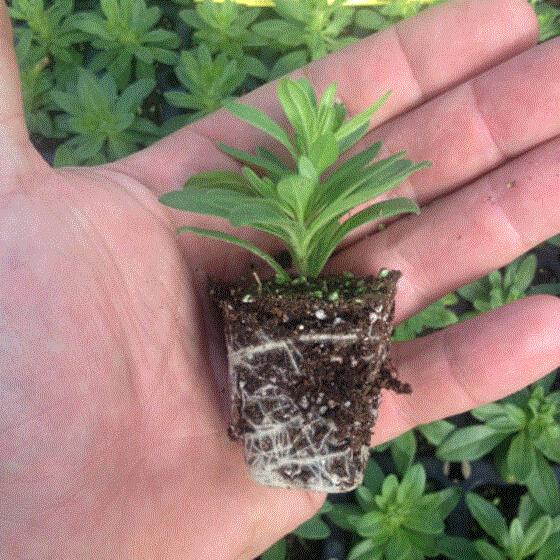
In the article, Tom Costamagna from Young’s Plant Farm in Alabama explains that when you combine PGRs, you must first understand the chemistries in regard to mode of action, method of application, absorption time, recommended uses and activity sites to nail down your desired response.
“There are no two greenhouses alike, and to determine the best results, it takes time in trialing multiple rates, genus/species and the various environmental conditions one experiences within a season and/or year to perfect consistent results,” he says.
Kerstin and her sources explain that some of the benefits that can be achieved include a “layered effect” that enhances the benefits of some different actives, labor savings in terms of liner handling and potential increases in the predictability of crop performance. Rates, regionality and absorption time is also discussed. There’s a ton of excellent info packed into this concise article. Check it out!

Must-read Article: Reduce Waste, Boost Profitability
An article from GrowerTalks' January issue has been on my list to share in the newsletter since I read it. It’s not necessarily a cultural or technical article, but it is one that can benefit all of you.
In HOW MUCH ARE YOU LOSING TO WASTE?, contributing columnist Stan Vander Wahl from Rainbow Greenhouses in British Columbia addresses the biggest drain on profits in any greenhouse: waste.
Stan lists any number of opportunities there are for waste in a greenhouse operation, from shipping and logistics to shrink and excess labor. I can pretty much guarantee that if you read his column, you’ll identify with at least one of the issues he brings up. With margins under pressure and costs rising across the board, now is the time to take a hard look at where waste is prevalent in your business.

Here are three of the multiple tips Stan shares in his must-read column:
-
Analyze your sales data. Be realistic about your production plan and produce to what you can sell at full price. Be sure to understand your customer, know your product mix and what sales trends are impacting your sales.
-
In the production cycle, constantly monitor inbound quality and the quality of the items you plant up. I like to use the term “If you start well, you have a much better chance of ending well.” If the cutting or plug you’re planting is mediocre, your chances of experiencing higher losses is greater. Critically assess your plants when doing tasks like spacing, and if the plant doesn’t meet your quality standard, dump it before you allocate more space, labor and energy to that plant. Most importantly, stick to your planned production numbers; don’t make the mistake of planting those extra plugs. Growers hate to throw something away, but it’s far cheaper to throw away a 30-cent liner than a finished plant worth $2.50.
-
Review your shipping process to ensure the quality you’re shipping will land at the store the way you shipped it out. So often we pack things too tightly on the cart, which has a direct impact on the plants or the sell-through at the stores. In other instances, shipments not properly wrapped or secured on the carts or trucks can quickly translate into 2% or 3% waste in shipping alone.

Nick’s Tip of the Week: Thielaviopsis on Late-Season Pansies
Each week, I’ll work with my buddy Nick Flax, a technical services expert at Ball, to share a concern that’s come up during one of his numerous calls with growers across North America. This week he’s addressing a pansy issue that’s come up more than once in the past week or two: Thielaviopsis.
PROBLEM: Spring pansy production was off to a solid start this year, but over the last few weeks I’ve gotten quite a few questions on late-season yellowing. Sometimes symptoms have been tied to crop cultural factors like overwatering and underfeeding, but the most concerning incidences have been due to late-season disease pressure—namely Thielaviopsis (also known as “black root rot”).
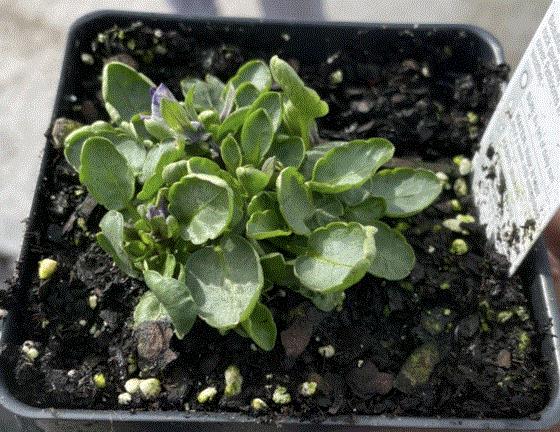
NICK’S TIP: Thielaviopsis basicola is one of the most pernicious pathogens affecting pansies, and if unmanaged it can rip through your crop at an alarming rate. This week, we’ll cover how to identify this pathogen and strategies to combat it before it’s too late.
Symptoms & Patterns
By the time you start to see symptoms of an infestation, it’s too late to save affected crops. However, it’s critical to catch early disease indicators and act quickly to reduce losses. Keep the following in mind when scouting your pansy crops each week:
-
Pansy roots should be bright-white and “fuzzy” in appearance. Cultural and environmental stressors can cause roots to lose their fuzziness, but if you start to see brownish discoloration on root tips as well, it’s often an early indicator of Thielaviopsis.
-
When disease symptoms in the rootzone are advanced, roots will appear dark brown to almost black in color (hence the name “black root rot”). However, a key differentiator between this pathogen and other root rots like Pythium or Phytophthora is that roots or infected crown tissue will remain somewhat firm in texture and not become mushy.
-
Slow growth and/or stunting is another common symptom, but pansies are seed-propagated and can have inherent differences in vigor from plant to plant, so this symptom is sometimes overlooked. Excessive substrate moisture and low mineral nutrition can also cause pansies to grow slowly, so be sure to pair slow growth or stunting with symptoms like root discoloration before acting. Failure to do so can result in jumping the gun and throwing away plants when disease isn’t present.
-
Lower leaf chlorosis and crown discoloration is an advanced symptom of infection. If you observe this in your pansy crop, quick action and a concerted cleanup effort will be necessary to prevent major losses.
-
Thielaviopsis spores move easily through water. If you start to see symptoms in plants that are “downstream” of symptomatic ones, this is another good indicator that Thielaviopsis may be the culprit.
-
This pathogen is a good survivor, and spores can remain viable for upwards of 12 months. If you have a Thielaviopsis outbreak in your pansies one year and have to use the same space to grow next year’s crop, scout this area diligently. Even if you do a thorough job cleaning and sanitizing, any spores that might remain pose a risk to your new crop.
Management Strategies
Because there are no curative treatment options for Thielaviopsis, prevention is key. Use the following strategies to prevent this pathogen from tearing through your crop, or to stop the spread and protect healthy plants in the event of an outbreak:
-
Monitor and manage growing media pH judiciously and target a range of 5.5 to 5.8. While pansies can tolerate a soil pH above about 6.0 toward the end of production without showing nutrient deficiency symptoms, Thielaviopsis thrives when soil pH exceeds 5.8. Check soil pH weekly, especially if you have moderate to high alkalinity in your water. Use acid-rendering fertilizer formulations to maintain soil pH in this ideal range and utilize acid injection or highly acidic fertilizers to reduce soil pH quickly if it spikes suddenly and exceeds 5.8.
-
Avoid overwatering, especially if you’re growing on the greenhouse floor or flood benches. Since Thielaviopsis spores move readily through water, leachate from infected plants is often the main vector for spreading disease. While it’s often difficult to modify your growing surface, reducing your leaching fraction is an easy way to reduce the risk of spreading disease.
-
Check substrate EC periodically and set about 1.5 mS/cm as your target for fertilizer salt levels in the media. Leach with clear water if readings begin to approach 2.0 mS/cm, because elevated EC can damage roots and increase the risk of infection, even if soil pH is below 5.8.
-
Fungicides containing thiophanate-methyl (ex. Banrot, Clearys 3336, OHP 6672—FRAC Group 1) and fludioxonil (Medallion—FRAC Group 12) are some of the harder-hitting preventative chemistries for Thielaviopsis in pansies. If you’re unable to keep soil pH below 5.8 or have had recent outbreaks of Thielaviopsis in your greenhouse, a preventative fungicide drench rotation containing these two active ingredients is highly advisable.
-
If you identify a Thielaviopsis infestation in your greenhouse, remove symptomatic plants and do not compost them or attempt to reuse growing media or containers. Plants immediately surrounding them may have been infected via spores in leachate from neighboring plants, so it is often beneficial to also remove the plants immediately surrounding symptomatic ones. Apply a fungicide containing one of the above active ingredients ASAP and monitor the crop closely for new symptoms.

Video: More on Pansy Finishing
Following up on Nick’s deep dive into Thielaviopsis on pansies, I wanted to mention a Tech On Demand video that also touches on this and other potential diseases in your finished crop.
Towards the end of the presentation, Dr. Will Healy looks at what you should watch out for in THIS VIDEO (fast-forward to 32:45).
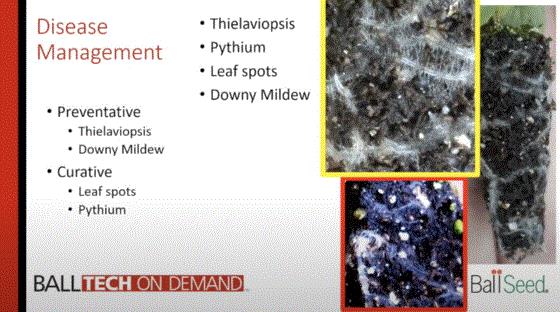
After disease management, Will wraps up the video with these postharvest prep tips and how to execute them:
-
Feed before shipping
-
Apply the appropriate fungicides
-
Apply PGRs at a rate that will only last one week after shipping
-
Cool down the soil to reduce shipping issues
Three New Biocontrol Papers from K-State
Dr. Raymond Cloyd and his fellow researchers at Kansas State University released three new papers covering three greenhouse biocontrol agents (BCAs)—rove beetle, insidious flower bug and Eretmocerus eremicus. These BCAs can assist with the management of some of the most common greenhouse pests, including fungus gnats and western flower thrips, insect and mite pests, and whiteflies. Each one is packed with information about the BCA and why it might be an excellent option for controlling these pests.
From the papers:
The rove beetle, Dalotia (formerly Atheta) coriaria, is a soil-dwelling predator used in greenhouse production systems to manage fungus gnat larval populations and the pupal stages (prepupae and pupae) of western flower thrips. THIS PUBLICATION provides information on the biology, feeding behavior, and rearing of the rove beetle.

The insidious flower bug, Orius insidiosus, is a predatory biological control agent that can be released into greenhouse production systems to manage populations of greenhouse insect and mite pests such as aphids, spider mites, thrips, and whiteflies.
THIS PUBLICATION discusses topics associated with the insidious flower bug, including biology, feeding behavior, commercial availability, and use in greenhouses.

Eretmocerus eremicus (formerly E. sp. nr. californicus) is a parasitoid of the greenhouse whitefly, Trialeurodes vaporariorum, and the sweetpotato whitefly, Bemisia tabaci. Eretmocerus eremicus can be released into greenhouse production systems to manage whitefly populations on ornamental and vegetable crops.
THIS PUBLICATION discusses biology and behavior, commercial availability, and quality assessment associated with E. eremicus.


Interveinal Necrosis on Dahlia
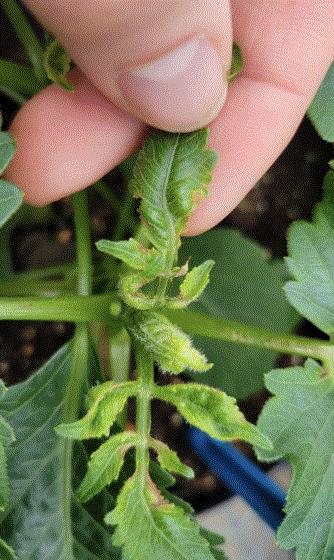
Here’s something the Tech On Demand team addressed with a grower last year that I want to share so you’ll hopefully avoid the same problem with your dahlias this season. Look at the marginal and interveinal necrosis on new growth and immature leaves in the photo:
After chatting with the grower who experienced the symptoms, our experts felt this is likely calcium deficiency. The recommendation was to apply a foliar feed with calcium nitrate or calcium chloride and to include CapSil or another surfactant to improve uptake.
After this application, it’s a good idea to continue feeding the dahlias with Ca-based fertilizer.
For even more information on nutrient disorders associated with dahlia crops, check out THIS VIDEO from Dr. Brian Whipker at NC State, released by our friends at e-GRO.
Finish Line ...
This week, I’m writing this from a hotel in Athens, Ohio, where I’ve been working with Tech On Demand experts Nick and Todd to put together a series of training videos, shot on location at Bob’s Market & Greenhouses in Mason, West Virginia. I’m truly grateful for these guys (and Ball videographer Osvaldo Cuevas) for taking the time to travel here and working tirelessly to share tips and tricks to help you reduce errors and optimize production.
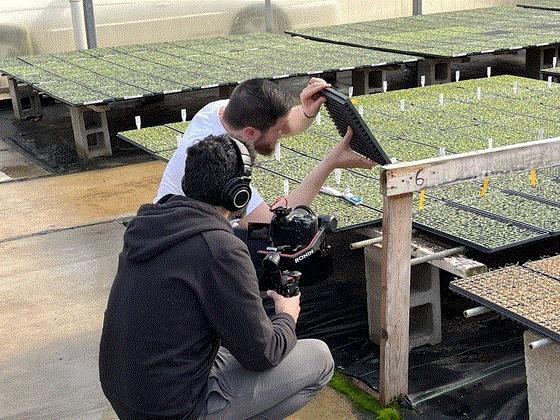
These videos will be launched soon and some of the topics discussed (and viewable in 4K UHD!) include seed storage, sowing, transplanting, pH and EC test methods and much more.
It's been a lot of fun watching these guys in action! I can’t wait to share the videos, so keep an eye on this newsletter in the coming weeks, because you’ll be the first one to get the links.
Please feel free to send your comments, constructive criticism and topic ideas to me at bcalkins@ballhort.com.

Bill Calkins
Editor - Tech On Demand
This email was received by you and 26,353 other fine subscribers!
If you're interested in advertising in Tech On Demand, contact Kim Brown ASAP and she'll hook you up.